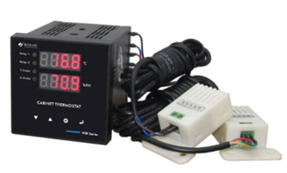Voltage detecting system is used for detecting voltage in various cabinets. This article will introduce the voltage detecting system from definition, types, working principle, and uses.
Definition
A Voltage Detecting System (VDS) is an indoor high-voltage live display device designed to detect and indicate the presence of voltage in electrical systems. It is an essential safety tool used to ensure that high-voltage equipment is properly de-energized before maintenance or repair work begins. By providing visual and sometimes audible signals, a VDS helps prevent accidental contact with live circuits, thereby enhancing the safety of personnel working on or near high-voltage equipment.

Types of Voltage Detecting System
Voltage detecting systems can be classified based on various criteria:
By Interface Type:

LRM (Low-Resistance Measurement): These systems use low-resistance measurement techniques to detect voltage presence. They are often used in environments where precise voltage measurement is crucial.
HR (High-Resistance Measurement): High-resistance measurement systems are designed for applications where high-impedance voltage detection is necessary. These are typically used in high-voltage applications to ensure accurate detection without significant power consumption.
By Relay Output:
With Relay Output: These voltage detecting systems include relay outputs that can trigger other safety mechanisms or alert systems when voltage is detected. This feature enhances the automation and safety integration within electrical systems.
Without Relay Output: These systems provide basic voltage detection without additional relay functionalities. They are simpler and often used in applications where only visual indication of voltage presence is required.
By Certification:
Voltage detecting systems can be categorized based on the certifications they possess, which ensure their compliance with specific safety and performance standards. Common certifications include IEC 62271-213:2021 or IEC 61243-5.
By Voltage Range:
For High Voltage: Systems designed to detect high voltages, typically used in power transmission and distribution networks where voltages range from several kilovolts (kV) to hundreds of kilovolts.
For Medium Voltage: Systems suited for medium voltage applications, such as industrial and commercial power distribution, with voltage levels typically ranging from 1 kV to 36 kV.
3. How Does a Voltage Detecting System Work?

A Voltage Detecting System operates by sensing the presence of voltage in electrical conductors or equipment. The working principle involves several key components and steps:
Sensing Element: The VDS is equipped with a sensing element, typically a capacitive or inductive sensor, that detects the electric field or current flow in the conductor.
Signal Processing: The detected signal is processed by an internal circuit that determines whether the voltage is present or absent. This circuit amplifies and filters the signal to ensure accurate detection.
Indicator: Upon detection of voltage, the system activates an indicator, such as an LED light or an audible alarm. In systems with relay outputs, the relay is triggered to perform additional actions, such as shutting down equipment or alerting personnel.
Feedback Loop: Some advanced VDS units include a feedback loop to continuously monitor the voltage presence and provide real-time updates on the status of the electrical system.
4. What is a Voltage Detecting System Used for?

Voltage detecting systems are used in various applications to ensure the safety and reliability of electrical systems. Key uses include:
Safety Verification: Before maintenance or repair work, a VDS is used to verify that high-voltage equipment is de-energized, preventing accidental contact with live circuits.
Preventive Maintenance: Regular use of VDS helps in identifying voltage presence, allowing timely intervention and maintenance to prevent equipment failure or accidents.
Operational Safety: In industrial and commercial settings, VDS enhances operational safety by providing real-time voltage status, ensuring that personnel are aware of the electrical conditions they are working with.
Compliance with Safety Standards: Use of certified VDS ensures compliance with safety regulations and standards, thereby minimizing legal and regulatory risks for organizations.
Conclusion
A Voltage Detecting System is a critical safety device in high-voltage and medium-voltage electrical systems. It ensures that maintenance and repair work can be performed safely by indicating the presence or absence of voltage. Various types of VDS, differentiated by interface type, relay output, certification, and voltage range, provide flexibility in application across different industrial, commercial, and residential settings. By understanding how VDS works and its applications, organizations can enhance electrical safety and reliability, protecting both personnel and equipment.






